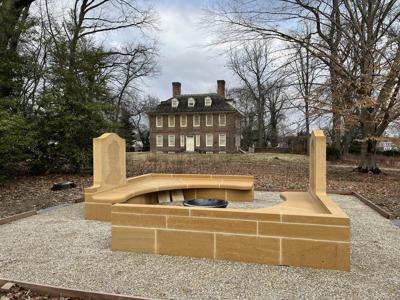On Saturday, April 20, Philadelphia’s first monument dedicated to a formerly enslaved woman will be unveiled on the grounds of Stenton, a magnificent 300-year-old home in the Logan section of the city near Germantown. The public is invited.
How is Lancaster County associated with this event?
The connection is James Logan (1674-1751), Stenton’s builder and the Penn family’s representative in Pennsylvania. Logan was the primary Quaker mover and shaker of the colony in the early 18th century, as well as a Lancaster County landowner.
At various times, Logan served as president of Pennsylvania’s Provincial Council, mayor of Philadelphia, chief justice of the Pennsylvania Supreme Court and acting governor.
Among other duties, Logan often presided at treaty sessions with American Indians on the Pennsylvania frontier. He understood maintaining good relationships with the Haudenosaunee (Iroquois) Confederacy and their wards, the Conestogas in Lancaster County, was crucial to Pennsylvania’s security.
In 1717, Logan set aside 500 acres for himself and 300 acres on a neighboring tract for fur trader John Cartlidge along the Conestoga River in what would become Manor Township. Logan also owned 100 acres across the river in Conestoga Township.
These lands, close to the Little Conestoga Creek’s confluence with the Conestoga River and the Conestoga’s outlet to the Susquehanna River, lay within walking distance of Conestoga Indian Town.
Logan built a store that would become the focal point for trade with Indians from a large region. Covered wagons called “Conestogas’’ rolled regularly between Logan’s trading post and Philadelphia.
Logan made a small fortune in the fur trade. He made even more money by taking his cut from the Penn family properties he sold in Lancaster and other settled areas. He created Stenton with this money.
He raised his family and accumulated nearly 3,000 volumes at Stenton. He became expert in botany, astronomy and mathematics. He corresponded with English, European and American scholars. He was at the epicenter of intellectual life in early Philadelphia.
Logan would have had difficulty achieving all of this without the labor of enslaved African-Americans and indentured servants. They built Stenton and maintained its interior and grounds, allowing him time to cultivate his intellect.
Until recent decades, almost no one mentioned the people James Logan enslaved.
Stenton’s staff, with the support of The National Society of the Colonial Dames of America in the Commonwealth of Pennsylvania, who have preserved Stenton since 1899, have researched the Logan family’s enslaved workers.
During the Revolutionary War, well after Logan’s death but while Stenton remained in the Logan family, an enslaved woman named Dinah, whom the family freed and then employed, prevented British soldiers from torching the mansion.
The Dinah Memorial project, funded by the Pew Center for Arts & Heritage, engaged the surrounding Black community to help design a fitting monument to Dinah. The memorial consists of two engraved limestone tablets and benches surrounding a small reflecting basin near Stenton’s main entrance along 18th Street in front of the house.
“As a historic site, we’re trying to tell the stories of everyone who lived here,’’ comments Rachel Corma, Stenton’s director of education,
James Logan was one of the most significant political and intellectual leaders of early Pennsylvania. He also enslaved African Americans and helped steal Bucks County territory from the Lenape Indians in the 1737 “Walking Purchase.’’
He was a vital but flawed figure in Pennsylvania history. Stenton intends to tell the entire story. See https://www.stenton.org/dinah.
Jack Brubaker, retired from the LNP staff, writes “The Scribbler’’ column every Sunday. He welcomes comments and contributions at scribblerlnp@gmail.com.


![Quakers have played a major role in Lancaster County’s history [The Scribbler]](https://bloximages.newyork1.vip.townnews.com/lancasteronline.com/content/tncms/assets/v3/editorial/8/01/8016a4fb-9d3b-52ca-8d41-364e8623e385/52314c069a6ca.preview-500.jpg?resize=150%2C103)
![Buchanan’s bronze sculpture to be brightened in Buchanan Park [The Scribbler]](https://bloximages.newyork1.vip.townnews.com/lancasteronline.com/content/tncms/assets/v3/editorial/2/7f/27f78b6a-e87b-11ee-a63b-f3405c4bd021/65fdcfc667809.image.jpg?crop=908%2C582%2C0%2C0&resize=150%2C96&order=crop%2Cresize)
![What do you know — Lancaster had 2 Know Nothing mayors [The Scribbler]](https://bloximages.newyork1.vip.townnews.com/lancasteronline.com/content/tncms/assets/v3/editorial/b/92/b925741a-8363-11eb-a71b-3b27e278eeb3/604bb7cd98845.image.jpg?resize=139%2C200)


